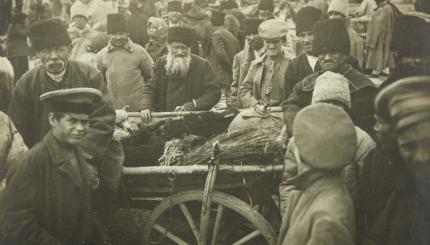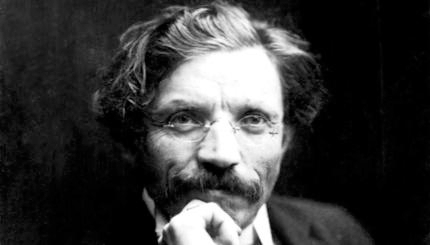According to the fantasist Neil Gaiman, one of Maurice Sendak’s many disciples, the only difference between scary adult books and scary children’s books is that the latter are scarier. This is certainly true of Sendak’s works–including Where the Wild Things Are and In the Night Kitchen–which often illuminate the most frightening parts of the worlds of young children.

Photo courtesy of Spike55151
Brooklyn Born
The child of Polish, Jewish immigrants, Sendak was born in Brooklyn in 1928. Early in life, he developed health problems and was forced to remain in bed for much of his youth, accompanied only by books, his own imagination, and his father’s stories.
Listening to these stories, his father’s “old country” became, for young Maurice, a mythical place, both adored and feared. He later drew on these childhood stories for his source material, and in much of his work there is a shadow of old Eastern European life. It is most frequently seen in his costumes and scenery, and in his nonlinear storytelling with Yiddish-specked sentences.
Reality and Escapism
Sendak’s first professional commissions, in the late 1940s, included contributing illustrations to a textbook, Atomics for the Millions, and creating window displays for the toy store F.A.O. Schwarz. Following a 1951 meeting with an editor at Harper, he illustrated his first picture book, and soon became a popular and in-demand illustrator of other people’s books–most famously the Little Bear series.

Help us keep Jewish knowledge accessible to millions of people around the world.
Your donation to My Jewish Learning fuels endless journeys of Jewish discovery. With your help, My Jewish Learning can continue to provide nonstop opportunities for learning, connection and growth.
Sendak drew pictures for children’s books for most of the 1950s, notably illustrating I.B. Singer‘s collection Zlateh the Goat, a retelling of Eastern European Jewish folktales.
Stirring Controversy, Craving Privacy
In 1956, Sendak published his first “solo” book, Kerry’s Window. It was an immediate success, and Sendak went on to write more of his own material.
One of his early attempts was a story of a boy who threw a temper tantrum, was banished to his room, and ran away to the place that gave the story its title, Where the Wild Horses Are. Just before committing the final drawings to paper, Sendak changed his wild horses into more ambiguous “wild things,” using the translation of the Yiddish expression “vildechaya,” which is common slang for a rambunctious child.
Wild Things was published in 1963. It was an immediate sensation, hailed critically and commercially, and it received the Caldecott Medal, awarded to the best American picture book for children published that year.
Some parents’ groups decried the story, protesting the depiction of a child yelling at his mother and running away from home. Others countered that the story depicted a clever, imaginative way of venting one’s anger productively, and pointed out that Max, the protagonist, actually becomes an authority figure for the Wild Things. Sendak himself had surprisingly little to say on the topic. He merely wanted to keep creating.
Nights, Kitchens, and Nazis
Seven years later, controversy struck again. Sendak’s story In the Night Kitchen depicted a young boy, Mickey, who woke up in the middle of the night and “fell through the dark and out of his clothes,” tumbling into a gigantic bowl of dough in the kitchen of his house. Though it is tangential to the book’s plot–which tells the story of Mickey fleeing in a suit of dough, chased by three huge bakers who want to roast him inside a cake–the panel that seized the public’s attention was a picture of Mickey falling through the sky, naked, with his penis visible.
Again, parent groups were up in arms. That page, and sometimes the whole book, was banned from some libraries and bookstores. Again, the public seemed to miss the true emotional center of the book: the confused and distorted world of a child’s dreams. The three bakers sported Hitler-like moustaches, and their determination to bake Mickey into a cake was his internalized fear of the Holocaust. Mickey’s final escape–aided by a Lindbergh-like toy biplane–wasn’t just an escape from a few wily bakers, but a full-fledged escape from being baked alive.
In this case, too, Sendak remained curiously indifferent to public opinion. He continued to produce a steady stream of his own work, to illustrate the books of others, and he involved himself in adaptations of his books. In the 1970s, an animated version of his book Really Rosie was made for television, with Carole King starring and writing original songs. In 1979, he helped an opera company produce a stage version of Wild Things.
The Second Coming
Throughout his life, Sendak had been adamant about both his own privacy and that of his creations. His low-key announcement that he is gay–in a New York Times article about his 80th birthday, published in September 2008–was uncharacteristic of the artist; for the better part of his life, he has volunteered surprisingly few biographical details.
For years, requests for licensing his illustrations and his characters, especially the Wild Things, were refused by Sendak or his representatives. It wasn’t until the late 1980s, when Sendak was more than 60 years old, that he permitted his characters to be commercially licensed–first for use in Bell Atlantic phone company commercials, and later in games and clothing.
Sendak continued more enthusiastically to engage in creative projects, such as a walk-through version of his books at the Please Touch Museum in Philadelphia (1995), and the record “Pincus and the Pig“–a shtetl-inspired retelling of “Peter and the Wolf” narrated by Sendak and performed by the Shirim Klezmer Orchestra (2004).
And he has continued releasing some startling projects. His 1992 book We Are All in the Dumps with Jack and Guy, which takes its words from two old English nursery rhymes, portrays the AIDS crisis, homelessness, environmental destabilization, and race riots without overtly mentioning any of them.
In October 2009, after a delay of several years, the Hollywood film adaptation of Wild Things was released. It was directed by Spike Jonze; Sendak was a producer. Before the film’s release, its distributors expressed concerns that the film was too dark in tone. Sendak himself convinced them to release it. In a documentary about the film, he raved that it “has an entire emotional, spiritual, visual life,” but warned that “there will be controversy.” It was a familiar sentiment from someone who has seen his own creative work under fire more than once.
From one point of view, it seems as though the work of Sendak is going through a renaissance. In another, it’s the same old story of Sendak’s life–adults are slowly discovering the secret universes that children have known existed all along.


